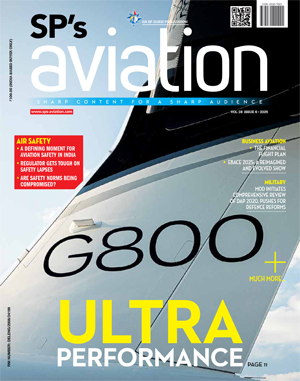INDIAN ARMED FORCES CHIEFS ON OUR RELENTLESS AND FOCUSED PUBLISHING EFFORTS

The insightful articles, inspiring narrations and analytical perspectives presented by the Editorial Team, establish an alluring connect with the reader. My compliments and best wishes to SP Guide Publications.

"Over the past 60 years, the growth of SP Guide Publications has mirrored the rising stature of Indian Navy. Its well-researched and informative magazines on Defence and Aerospace sector have served to shape an educated opinion of our military personnel, policy makers and the public alike. I wish SP's Publication team continued success, fair winds and following seas in all future endeavour!"

Since, its inception in 1964, SP Guide Publications has consistently demonstrated commitment to high-quality journalism in the aerospace and defence sectors, earning a well-deserved reputation as Asia's largest media house in this domain. I wish SP Guide Publications continued success in its pursuit of excellence.
- Prime Minister Modi Visits Punjab’s Adampur Air Base, Interacts with Airmen after Successful ‘Operation Sindoor’; Stern Message to Pakistan
- The layered Air Defence systems that worked superbly, the key element of Operation Sindoor
- Operation Sindoor | Day 2 DGMOs Briefing
- Operation Sindoor: Resolute yet Restrained
- India's Operation Sindoor Sends a Clear Message to Terror and the World – ‘ZERO TOLERANCE’
- Japan and India set forth a defence cooperation consultancy framework, talks on tank and jet engines
Joint Strike Fighter
Air Marshal (Retd) V.K. BhatiaAlternate Engine Programme Gets yet another Breather
 |
The alternate engine programme began in FY1996, when the DOD (Department of Defense) was given a Congressional directive to ensure that the JSF (then ‘JAST’) programme “provides for adequate engine competition”. Till 2009 the US Congress had provided approximately $2.5 billion for the JSF alternate engine programme. With 70 per cent of the development already over, the programme is projected to need an additional $2 billion or so to complete the development of the F136 engine. It is interesting to note that initially, in the absence of any competition, it had cost $7.2 billion for P&W to develop the F135 engine.
Pentagon’s opposition to the continuation of the alternate engine programme is mostly driven by immediate budget pressures and its penchant for cutting down costs without taking a long-term view of the pros and cons of the F136 programme on the overall F-35 programme which, topping $300 billion would be the biggest ever in military history. The total number of different versions of the jet fighter to be acquired by the US and its Allies exceeds 3,000 airplanes.
Critics of the proposal to terminate the alternate engine programme have argued that, in the long run, competition brings about its own savings as it happened in the case of F-15 and F-16 programmes. Cancelling the F136 engine also poses questions on the operational risks - particularly of fleet grounding - by putting “all eggs in the same basket”. Additional issues may include the possible potential impact the termination would have on the US industrial base and on US relations with key allied countries involved in the alternate engine programme.
However, even if the ‘Pentagon’ was to give a ‘go by’ to the international relations and Allies’ sensitivities in pursuance of its own self-driven narrow interests, it should realise that ‘Competition’ always makes good economic sense - more so in a programme of such gigantic dimensions and longevity. There is a $100 billion tag attached to the engines which will power the over 3,000 F-35s, to be in production for at least another 25 years till 2035. It is estimated that if the F136 programme is allowed to continue to its logical conclusion, the competition itself could generate savings of up to $20 billion over the entire range of production and in-service operational utilisation of the airplane. $4.5 billion, of which $2.9 billion having been already spent would then be a good investment purely in the financial terms alone, even without looking at the multifarious operational advantages and, must therefore, be pursued in all earnestness.





